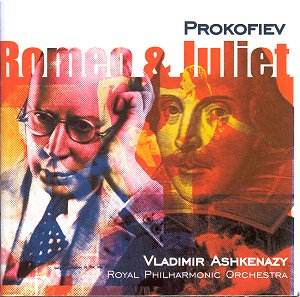This is probably Prokofiev’s greatest work. In
my recent essay
I suggested that most conductors play Prokofiev’s music well because
the scores are written so skilfully to the orchestra’s capabilities.
Differences in quality of performance were mostly due to whether
the conductor just played the notes as written (good) or tried
to gush and emotionalise (bad). Stravinsky has made similar comments
on his own music, that is to say that he puts all the emotion
he wants in the notes and additional ‘pumping’ on the conductor’s
part is not required. The finest live concert version of Romeo
and Juliet excerpts I’ve heard was Leinsdorf and the Los Angeles
Philharmonic Orchestra. The orchestra was so undisciplined at
that time and Leinsdorf was so angry at them that they played
the Death of Juliet as though they were afraid he was going
to kill them. It worked.
Having recently surveyed several video presentations
of Romeo and Juliet it was an additional treat to re-listen
to the audio-only versions. Most of the dances are played about
the same by everybody, but there are some test points where the
drama is focused and where the skill of a great conductor shows
clearly. In a good live performance by the time you get to the
Death of Juliet you are likely not to be hearing terribly
well for the noise of your own crying. So, in evaluating a live
performance we have to jump there cold and attempt to maintain
objectivity. But none of the pit orchestras plays with anywhere
near the skill found in these two concert recordings.
These are both excellent performances. The digital
sound gives Ashkenazy an advantage, particularly the extra orchestral
transparency, the ‘air’ around the violins and bass strings. Played
in Dolby 5.1, Maazel is strictly in the front speakers, whereas,
while nothing jumps up behind you, Ashkenazy’s sound has a nice
room ambience to it. Regarding the interpretation, one could say
Maazel plays the music a little more like an orchestral tone poem,
whereas I think you could mount a ballet to the Ashkenazy performance
with its slight extra crispness on the tempo. Both recordings
are very clear on the many percussion accents. Both performances
bring searing passion to the dramatic climaxes.
If you have the Maazel recording and are pleased
with it, you may confidently continue to be so. If you have neither,
the Ashkenazy should be your first choice. The notes point out
that the suites were assembled from the original score, which
was then revised for the first Russian performance to suit the
acoustics of the theatre, so there is a difference in the orchestration.
Thus, if you are a complete collector, you must have the suites
also. And, a real devotee will want to hear the marvels Bella
Davidovich obtains with Prokofiev’s piano arrangements of seven
of the dances on Philips 412 742-2.
Paul Shoemaker

![]() Royal Philharmonic
Orchestra/Vladimir Ashkenazy
Royal Philharmonic
Orchestra/Vladimir Ashkenazy ![]() DECCA 436 078-2 2 CD’s
[141.28]
DECCA 436 078-2 2 CD’s
[141.28]